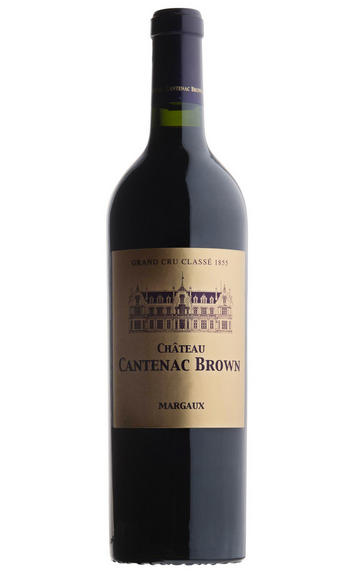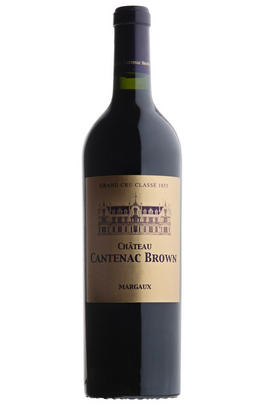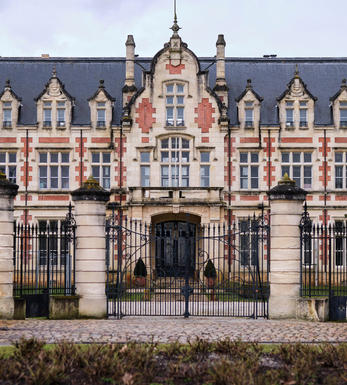
2021 Château Cantenac Brown, Margaux, Bordeaux

Critics reviews
The 2021 Cantenac Brown has an open, expressive bouquet of tobacco-tinged red fruit and well-integrated oak. The palate is medium-bodied with fine tannins, light red berry fruit mixed with sage and cedar, and perhaps a very slight herbal element on the finish. Winemaker José Sanfins has crafted a fine-boned Cantenac Brown, one that is more suited to early drinking than recent vintages.
Drink 2027 - 2040
Neal Martin, vinous.com, (May 2022)
Ruby red depth to the colour with violet edging. Not as luxurious as the past few years of Cantenac Brown have been, but excellent quality, well put together, finessed and powerful with black cherry fruits and raspberry puree, with tiny pulses of lemongrass acidity. 60% new oak barrels for ageing.
Drink 2026 - 2040
Jane Anson, janeanson.com (May 2022)
The 2021 Cantenac Brown is another fine effort from a Margaux estate that's been on something of a roll of late. Unwinding in the glass with notions of cassis, wild berries, loamy soil and cigar box, it's medium to full-bodied, layered and seamless, with good concentration, lively acids and a nicely defined finish. José Sanfins and his team opted to wait to pick the estate's Cabernet Sauvignon between the fourth and 12th of October, and that appears to have paid off. The blend is 73% Cabernet Sauvignon and 27% Merlot, and just over half the estate's production went into the grand vin.
William Kelley, Wine Advocate (Apr 2022)
Deep, glowing crimson. Intense nose of blackberries. Round – as though very carefully worked. Not desperately long and with quite marked acidity but the phenolics were certainly ripe enough. Clean and fresh. Just slightly lacks the flesh of the Giscours 2021 tasted alongside.
Drink 2027–2038
Jancis Robinson, jancisrobinson.com (May 2022)
About this WINE

Chateau Cantenac Brown
Cantenac-Brown, a 3ème Cru Classé estate, is located in the Haut-Medoc wine appellation on the western extremes of the Margaux appellation.
As with so many Bordeaux estates, the tale of the last 120 years focuses on early years of problems, caused by both vineyard diseases and economic depradations, followed by recent revival once the property has been bought by someone with the means to invest properly in its future.
The revitalisation of Cantenac-Brown only really looked a realistic possibility with its acquisition in by AXA Millésimes in 1989. The AXA team, led at that time by the since semi-retired Jean-Michel Cazes, with the help of Daniel Llose and under the direction of Christian Seely, began to turn the estate around. The team had a history of success in Bordeaux, not least at Lynch-Bages but at other estates such as Pichon-Baron, Suduiraut and Quinta do Noval.
Cantenac Brown has 42 hectares of vineyards - 65% Cabernet Sauvignon, 30% Merlot and 5% Cabernet Franc.
Cantenac Brown is typically Margaux in character - fragrant and perfumed on the nose and medium bodied and harmonious on the palate, with soft cassis-scented fruits and a lingering finish.

Margaux
If Pauillac can be seen as the bastion of ‘traditional’ Red Bordeaux, then Margaux represents its other facet in producing wines that are among Bordeaux’s most sensual and alluring. It is the largest commune in the Médoc, encompassing the communes of Cantenac, Soussans, Arsac and Labaude, in addition to Margaux itself. Located in the centre of the Haut-Médoc, Margaux is the closest of the important communes to the city of Bordeaux.
The soils in Margaux are the lightest and most gravelly of the Médoc, with some also containing a high percentage of sand. Vineyards located in Cantenac and Margaux make up the core of the appelation with the best vineyard sites being located on well-drained slopes, whose lighter soils give Margaux its deft touch and silky perfumes. Further away from the water, there is a greater clay content and the wines are less dramatically perfumed.
Margaux is the most diffuse of all the Médoc appelations with a reputation for scaling the heights with irreproachable wines such as Ch. Margaux and Ch. Palmer, but also plumbing the depths, with too many other châteaux not fulfilling their potential. There has been an upward shift in recent years, but the appellation cannot yet boast the reliability of St Julien. However, the finest Margaux are exquisitely perfumed and models of refinement and subtlety which have few parallels in Bordeaux.
Recommended Châteaux: Ch. Margaux, Ch. Palmer, Ch. Brane-Cantenac, Ch. Rauzan-Ségla , Ch. Dufort-Vivens, Ch. Ferrière, Ch. du Tertre, Ch. Giscours, Ch. d'Angludet.

Cabernet Sauvignon Blend
Cabernet Sauvignon lends itself particularly well in blends with Merlot. This is actually the archetypal Bordeaux blend, though in different proportions in the sub-regions and sometimes topped up with Cabernet Franc, Malbec, and Petit Verdot.
In the Médoc and Graves the percentage of Cabernet Sauvignon in the blend can range from 95% (Mouton-Rothschild) to as low as 40%. It is particularly suited to the dry, warm, free- draining, gravel-rich soils and is responsible for the redolent cassis characteristics as well as the depth of colour, tannic structure and pronounced acidity of Médoc wines. However 100% Cabernet Sauvignon wines can be slightly hollow-tasting in the middle palate and Merlot with its generous, fleshy fruit flavours acts as a perfect foil by filling in this cavity.
In St-Emilion and Pomerol, the blends are Merlot dominated as Cabernet Sauvignon can struggle to ripen there - when it is included, it adds structure and body to the wine. Sassicaia is the most famous Bordeaux blend in Italy and has spawned many imitations, whereby the blend is now firmly established in the New World and particularly in California and Australia.


Buying options
Add to wishlist
Description
Cabernet Sauvignon 73%, Merlot 27%
Technical Director José Sanfins pushed the ripening of his Cabernet well into October but still chose to chaptalize; he also performed some saignée on his Merlot. This very sensible approach maximised fruit concentration and brought balance. The Cabernet drives the wine, which is full of cassis and sandalwood notes. But the intense Merlot provides a juicy, tangy and headily perfumed note. The wine is overt now, though doubtless will become more compact during the élevage. But this is clearly a wine of full-frontal pleasure. Drink 2026-2040.
Our score: 15.5/20
Berry Bros. & Rudd, April 2022
wine at a glance
Delivery and quality guarantee